
The Five Poisons
One of the most dangerous and inauspicious days of the year in ancient China was the 5th day of the 5th month, according to the lunar calendar, which was popularly referred to as "Double 5" or "Double 5th", and also known as tian zhong jie (天中节). This day marked the beginning of summer which by midseason meant dangerous animals and insects, the spread of infectious diseases, and the appearance of evil spirits.
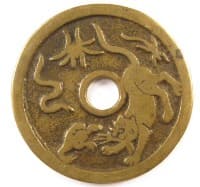 Furthermore,
the
most
dangerous
period of that day was considered to be "noon". The
Chinese actually divided each day into twelve two-hour
periods known as shichen (时
辰). "Noon", then, would be the two hour period from 11AM
- 1PM which according to shichen
is called wu (午).
Furthermore,
the
most
dangerous
period of that day was considered to be "noon". The
Chinese actually divided each day into twelve two-hour
periods known as shichen (时
辰). "Noon", then, would be the two hour period from 11AM
- 1PM which according to shichen
is called wu (午).One popular way to protect oneself during this day was to drink realgar wine (xiong huang jiu 雄黄酒). Realgar contains arsenic sulfide which was believed to be an antidote for poisons and would therefore drive away evil spirits and kill insects and other poisonous animals.
Since realgar wine was too strong for children to drink, parents would use the wine to write the Chinese character "king" (wang 王) on a child's forehead as a form of protection.
The Chinese would also mix into wine powdered cinnabar (dan sha 丹砂 or zhu sha 朱砂), which is the mineral from which mercury is made. The cinnabar would turn the wine red which the Chinese believe would help fend off attacks from evil spirits.
Other protective measures included hanging branches of artemisia or mugwort (ai 艾) over gates and doors because the leaves resemble the paws of tigers and the aroma is believed to repel insects. Calamus or "sweet flag" is also hung above gates because the leaves resemble swords.
It was also customary to hang pictures of Zhong Kui, brandishing his magic sword which could slay evil spirits, on doors and gates.
However, one of the most common forms of protection from the dangers was the wearing of "five poison" charms. Chinese parents would also have their children wear an amulet bearing the images of the five poisons or hang small bags filled with mugwort around their necks.
Examples of old five poison charms are displayed and discussed below.
It should be noted also that in China today the fifth day of the fifth month is celebrated as the popular Duanwu Festival (duan wu jie 端午节) or "Dragon Boat Festival". The day commemorates the life and suicide of Qu Yuan (屈原) (340 BC - 278 BC), a famous poet and minister from the State of Chu of the Warring States Period.
The "five poisons" (wudu 五毒) actually refer to five poisonous animals. In contrast to what one might expect, the purpose of the five poisons depicted on an amulet is to counteract pernicious influences. This is because the Chinese believe in combating poison with poison as shown by the above examples of drinking realgar (arsenic) wine and mixing cinnabar (mercury) with wine.
There is legendary evidence to support this belief of combating poison with poison. Shennong (神农), also known as the Yan Emperor (yandi 炎帝), was a ruler who lived about 5,000 years ago and is credited with teaching the Chinese how to cultivate crops. He is also considered the Father of Chinese Medicine because he discovered and personally tested upon himself hundreds of medicinal and poisonous herbs. He was able to test these herbs because he allegedly had a transparent body and could therefore observe their effects. He never suffered long-term effects, however, because the poisons apparently canceled each other out.
Some historical sources refer to the five poisons as consisting of the snake, scorpion, centipede, toad and spider. Other references have the lizard replacing the spider. Still other sources mention the five poisons as the snake, scorpion, centipede, spider and the "three-legged toad". (Learn more about the "three-legged toad" at Liu Hai and the Three-Legged Toad.)
Finally, the tiger is sometimes included as one of the five poisons as explained below.
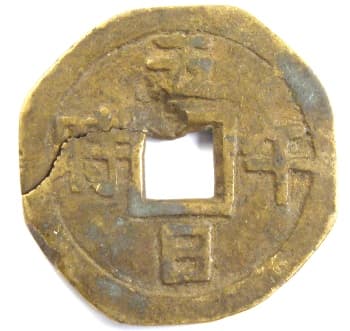
The inscription on this charm reads wu ri wu shi (五日午时) which translates as "noon of the 5th day" and which refers to noon on the 5th day of the 5th month.
As you can see, the charm has a crack. If you look closely, you will see an area at the upper left of the square hole that has been flattened. Most likely, this charm was at some time nailed to the gate of an old traditional Chinese house to protect the family from evil spirits and poisonous animals associated with this unlucky day.
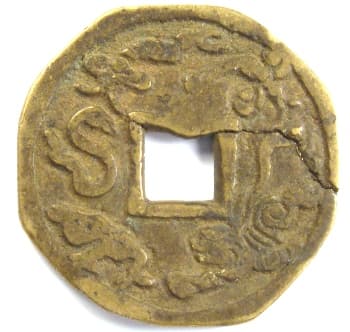 The reverse
side of the charm displays members of the five poisons.
The reverse
side of the charm displays members of the five poisons.Above the square hole is the centipede with its venomous claws.
At the upper right is a lizard. Unfortunately, the lizard's head has been flattened by the nail so that the only discernable feature is the tail.
At the lower right is a tiger which is shown running in full stride.
The tiger is the only member of the group that is not poisonous so why is it included with the five poisons?
The reason has to do with the nature of the tiger. The Chinese consider the tiger to be a solitary animal.
There is an old Chinese proverb which says hu du bu chi zi (虎独不吃子) which literally means "tiger solitary does not eat children. The character for "solitary" (独) and the character for "poison" (毒) are both pronounced du. When spoken, the proverb can thus be interpreted as "tiger poison does not eat children".
Tigers are frequently included on amulets of this type for this reason and also because they see well in the dark and have the ability to make evil spirits flee.
At the lower left is the three-legged toad which is discussed in detail at Liu Hai and the Three-Legged Toad.
To the left of the square hole is the snake.
There is one final point worth noting about this charm. You will notice that, unlike most charms, this particular charm is not round. It is actually eight-sided.
This eight-sided shape is believed to enhance the effectiveness of the charm because the number "8" (ba 八) is a lucky number due to its similar pronunciation in certain Chinese dialects to the word "prosper" or "wealth" (fa cai 发财).
This charm has a diameter of 29 mm and a weight of 7.5 grams.
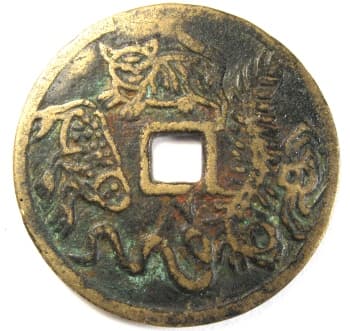
On the left is shown the reverse side of an amulet with the centipede and spider to the right, the snake at the bottom and a "three-legged toad" to the left of the center hole.
The animal at the top is a tiger. Tigers are sometimes put on amulets because they are believed to have the ability to set evil spirits to flight and because they see well in the dark.
Images of tigers (see Peach Charms) are considered particularly effective in scaring away malignant spirits and protecting children.
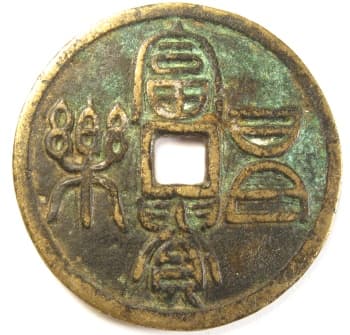
While the reverse side of this piece is meant to protect, which is the purpose of an amulet, the obverse side is more like a charm in that it is meant to bring good luck.
The obverse side, shown at the left, has the four Chinese characters fu gui chang le (富贵昌乐) written in seal script and read top to bottom and right to left.
The meaning is "riches and honor, prosperity and happiness".
This charm has a diameter of 47.8 mm and weighs 25.9 grams.
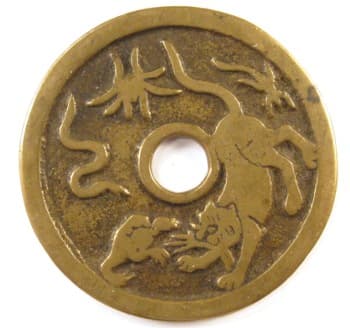
This is the reverse side of another old Chinese five poison charm.
The large animal at the right is a tiger or cat. To the right of the cat's tail is a lizard and to the left is a spider. A snake is at the left of the center hole and the three legged toad is at the lower left.
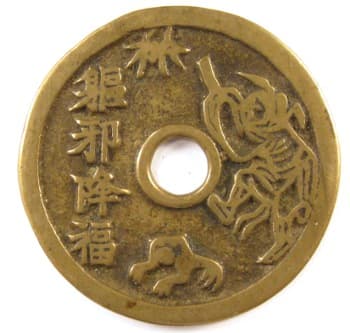 The
inscription on the obverse side of the charm is read top to
bottom as qu xie jiang fu
(驱邪降福) which translates as "Expel evil
and send down good fortune".
The
inscription on the obverse side of the charm is read top to
bottom as qu xie jiang fu
(驱邪降福) which translates as "Expel evil
and send down good fortune".At the very top of the charm is a spider. In this case, the spider is not one of the five poisons. When not grouped with other members of the five poisons the spider is actually considered an auspicious symbol on its own. This is because another word for spider in Chinese is xizi (虫喜 子) where the first character has the same pronunciation as the word for "happy" (xi 喜). A picture of a spider dropping down is therefore a visual pun for "happiness being sent down from the sky".
At the bottom of the charm is the three legged toad. The three-legged toad on charms is regarded as auspicious and conducive to good fortune. For a more detailed discussion, please see Liu Hai and the Three-Legged Toad.
There is some disagreement as to the figure at the right. Some say it is Liu Hai and others say it is Zhong Kui. For a detailed discussion of Liu Hai, please see the above link. For information on Zhong Kui, please see Daoist (Taoist) Charms and Chinese Pendant Charms.
This charm has a diameter of 46 mm and a weight of 26.3 grams.
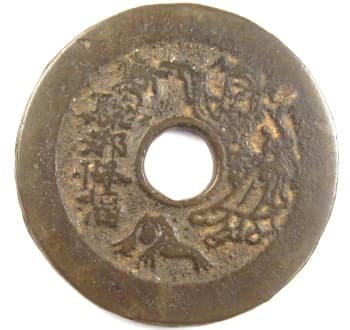
The charm at the left is very similar to the one above although the person on the right appears to be different.
The inscription is qu xie jiang fu (驱邪降福) meaning "expel evil and send down good fortune".
This charm also has the spider, here representing "happiness", at the eleven o'clock position and the three-legged toad at the bottom.
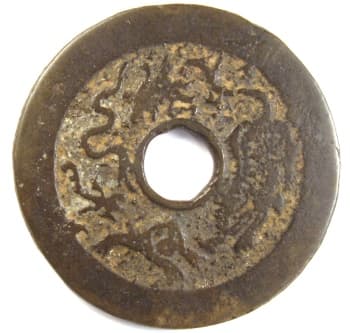
The images of the "five poisons" on the reverse side are the same as those on the above charm although they are drawn a little differently and are in a slightly different order.
Beginning at the right and moving clockwise are the tiger, three-legged toad, lizard, snake and spider.
This charm has a diameter of 44 mm and a weight of 24.6 grams.
Return to Ancient Chinese Charms and Coins
